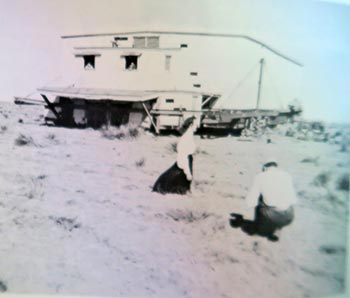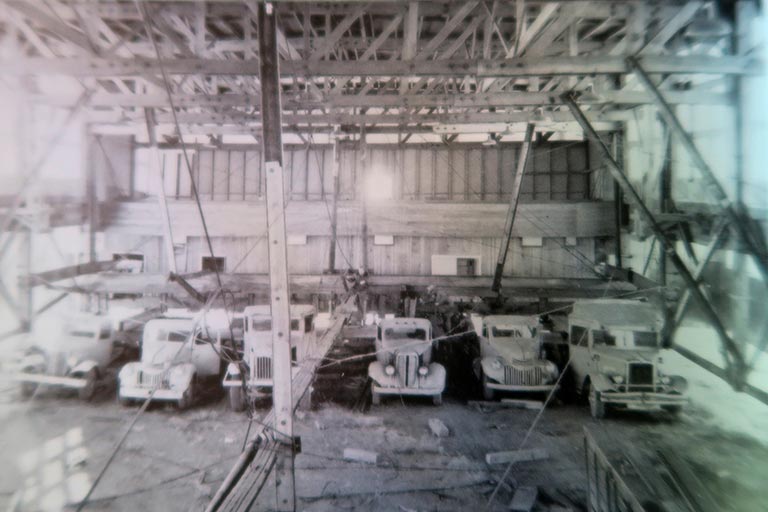"The Golden Years: 1928-1960," authored by Dr. Floyd Golden, the late second president of Eastern New Mexico University, details the years preceding the 1934 opening of Eastern through 1960.
Chapter 5
"Era of Growth and Expansion, 1945-1960"
After World War II ended, students flooded Eastern in such numbers that the school found itself short of everything. School administrators knew that wartime experiences had changed the attitudes of students and they understood the need for more education.
During 1944-45, Eastern had only 276 students. In 1945-46, enrollment almost doubled to 511.
Qualified faculty members for higher education were difficult to find since most institutions were desperately seeking teachers to meet the influx of students. Many college professors left the profession during the war for better opportunities and did not return.
Many areas in technology had opened during the war caused a major shift in student interest to sciences and mathematics. This made it doubly hard to find teachers in those areas. Eastern felt lucky to find 11 new faculty members for 1945-46.

being transported from Ft. Sumner.
Professors noticed that the quality of students' work improved significantly after the war. Many students had rather poor academic records prior to enlistment, but upon their return, changed radically from mediocre and inferior students to excellent and good students.
Some returning students had been injured and were physically handicapped, while others were suffering from war-related emotional problems.
After the war, the government began closing military bases and made buildings and other surplus material available to educational institutions. Eastern obtained 20 buildings, 20x120 feet, containing five apartments each from a base at Ft. Sumner, New Mexico. The buildings were cut in half and moved to campus for married student housing. Rent ranged from $18 per month for a one-bedroom apartment to $24 for two bedrooms to $30 for three bedrooms.
The military base at Ft. Sumner also became the source for several other buildings on campus. A military hangar became the school's gymnasium. When the building was completed, the seating capacity of 3,600 people made it the largest gymnasium in New Mexico.
Another large building was moved from Ft. Sumner to be used as a vocational building. The 128x164 foot building was moved in one piece across 65 miles the rough terrain of ranches, farms, fences, highways, railroad tracks and power lines.
A 50x100 foot theatre that could seat 600 was also moved in one piece.
Ft. Sumner was also the source of four large hospital buildings moved to campus. They formed a quadrangle on campus with a patio in the center. The quadrangle, located just southwest of the Administration Building, contained 11 large classrooms, 24 faculty offices, two restrooms, two faculty lounges and four janitorial storage closets.
Eastern also received an infirmary building from the base. It contained five bedrooms, a convalescing room, a reception room, offices for the nurses and doctors, an apartment for a nurse and two bathrooms. Eastern also received all the beds and medical equipment from the infirmary.
The school already had a full-time nurse and a part-time doctor on campus, and now had the facilities and equipment they needed.
Eastern also received six large buildings from Ft. Sumner that were located near the dairy farm to house the maintenance department and for storing surplus property.
In addition, the school received three 20x100 feet buildings from the military base at Hobbs. They were used to house the vocational agricultural shop and classrooms, as well as the Department of Agriculture.
In addition to buildings, the school received tons of surplus property, including science equipment, vehicles, radios, vocational equipment, shop equipment, cafeteria equipment, educational supplies and janitorial supplies.
Eastern New Mexico College reached a milestone when it was accredited by the North Central Association at a meeting on March 28, 1947, in Chicago. When President Golden called the news back to campus from the meeting, administrators, faculty and students who had gathered in the Administration Building in anticipation of the call erupted into loud cheering.
When President Golden arrived back in Portales by train at 3 a.m., a mass of people was milling about the platform. Suddenly, a band started playing, and the crowd started cheering his arrival. That was when he fully realized how important accreditation was to the students.
At its meeting on April 5, 1949, the Board of Regents voted to change the name of the school to Eastern New Mexico University and approve graduate work leading to the Master of Arts and Master of Science degrees. Graduate registration for the 1949 summer session totaled 78 students.
The North Central Association accredited Eastern's graduate program in 1953. Eastern became the youngest school ever accredited by the Association for the bachelor's and master's degrees.
With funds from fees students agreed to, the Campus Union Building was built in 1950. Included were a lounge, refreshment lounge, coffee shop, bookstore, game room, ballroom, banquet room, six guest bedrooms on the second floor and restrooms.
The two-story library was built in 1953 for $750,000. The 35,000-square-foot facility housed 250,000 volumes and would seat 400 students.
The expansion of the campus continued so rapidly that by homecoming weekend of 1955 the school broke ground for six new buildings at the same time. The buildings were Technology, Music, Theatre, Natatorium (swimming facility) and men's and women's residence halls.
By 1960, the value of Eastern's entire campus was estimated at $15 million. The value of the entire campus in 1934 was approximately $65,000.
The campus grew from 43 acres during its 1934 opening to 180 acres at President Golden's 1960 retirement.
Students were attending Eastern from all parts of the nation and a number of foreign countries. Students ranged in age from as young as 15 to 83.
When 83-year-old Parlee Witt from Amarillo was asked why she enrolled at ENMU, she said, "I have heard so much about the University that I knew they would have something really worthwhile to offer me and that I felt a person never gets too old to learn."
After she met Dr. Golden in his office, she told him, "Young man, you are too young to be President of the University."
From 1950 to 1960 the University's budget increased from $815,466 to $2,514,441. The average faculty salary almost doubled during the decade. In 1959-60, Eastern had the highest average faculty salary in 11 Southwestern states.
In 1958, junior colleges were opened in Lovington and Roswell under the administration of ENMU. In 1959-60, there were 1,990 students on the main campus and over 700 at the two junior colleges for a total enrollment of over 2,700 students.




